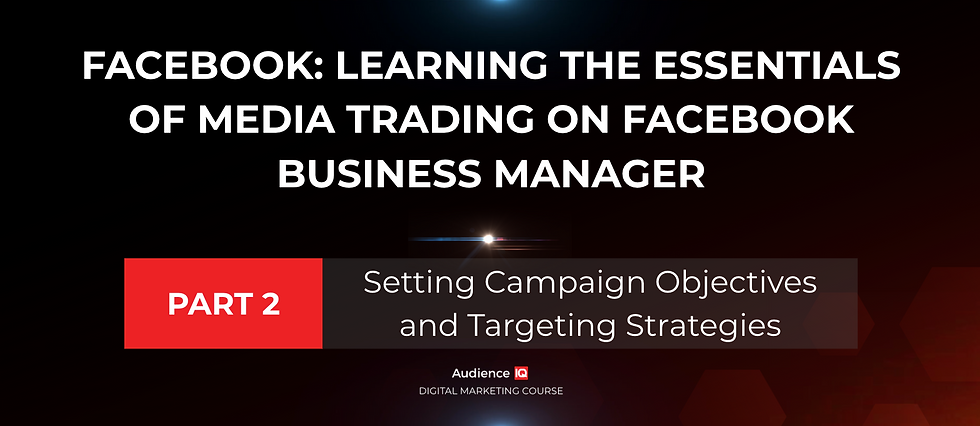Facebook: Learning the Essentials of Media Trading on Facebook Business Manager Part 4: Optimization, Analytics, and Pixel Tracking
- Sofie Pakula
- Oct 27
- 3 min read

Optimization, Analytics, and Pixel Tracking
Launching a Facebook campaign is just the first step. The real performance gains come from analyzing your data, understanding user behavior, and refining campaigns based on what drives results.
In this final part of our Facebook Media Trading Deep Dive series, we’ll explore how to optimize campaigns over time, use the Facebook Pixel for precise tracking, and extract insights from analytics to guide smarter decision-making.
Why Optimization Never Stops
Optimization is a continuous process — every click, impression, and conversion reveals data that can improve your next campaign. Successful advertisers treat their campaigns as living systems that evolve with audience behavior, creative trends, and platform changes.
By consistently refining targeting, bidding, and creatives, you improve your Return on Ad Spend (ROAS) while lowering overall acquisition costs.
Understanding Facebook Pixel
The Facebook Pixel (now integrated into Meta’s Conversions API) is the foundation of campaign tracking and optimization. It collects data on user actions after they interact with your ad, allowing Facebook to:
Measure conversions accurately
Optimize delivery toward high-value users
Build Custom and Lookalike Audiences
Retarget visitors who didn’t complete a purchase or form
Common Pixel events include:
View Content: User views a product page
Add To Cart: User adds an item to their cart
Initiate Checkout: User starts checkout
Purchase: User completes the transaction
Lead: User submits a form
Pro Tip: Ensure Pixel (or Conversions API) is properly installed and firing correctly using Meta’s Test Events Tool in Events Manager.
Tracking the Right Metrics
Not every metric tells the full story. The key to optimization lies in focusing on actionable metrics tied to your campaign objectives.
Objective | Key Metrics to Track |
Awareness | Impressions, Reach, Frequency |
Consideration | CTR, Engagement Rate, Video Views |
Conversion | CPA, ROAS, Conversion Rate |
Monitor your Cost per Result closely — if costs rise but performance drops, review your targeting, creative fatigue, and bidding strategy.
Bidding and Budget Optimization
Facebook’s bidding system runs on an auction model, where relevance and engagement quality often outweigh bid amount.
Bidding Strategies to Consider:
Lowest Cost: Facebook gets the most results for your budget automatically.
Cost Cap: Keeps your average cost per result under a target threshold.
Bid Cap: Gives full control over bid limits but requires more management.
Budget Optimization Tips:
Use Campaign Budget Optimization (CBO) to let Facebook allocate budgets automatically between ad sets based on performance.
Reallocate spend to top-performing audiences or creatives.
Avoid frequent budget changes — they reset the algorithm’s learning phase.
Reading and Reporting Performance
Analytics transforms campaign data into business intelligence. Within Meta Ads Manager, focus on performance breakdowns by:
Placement: Identify which channels (Feed, Reels, Stories) perform best.
Demographics: See which age groups or genders convert most efficiently.
Device: Compare mobile vs. desktop performance.
For deeper insights, integrate with Meta Business Suite or Google Analytics 4 (GA4) to track multi-touch attribution and understand how Facebook fits into your full customer journey.
Scaling Campaigns Effectively
Once a campaign performs well, scaling becomes the next challenge. To grow efficiently:
Increase budgets gradually (no more than 20% per day) to avoid reentering the learning phase.
Duplicate winning ad sets and test them with new audiences.
Refresh creatives regularly to prevent ad fatigue.
Use Advantage+ Shopping Campaigns for e-commerce — Meta’s AI will dynamically allocate spend to top-performing products.
Sustainable scaling is about balance — pushing performance while maintaining cost efficiency.
Best Practices for Ongoing Optimization
Daily: Monitor delivery, spend, and conversion fluctuations.
Weekly: Review creative fatigue and replace underperforming assets.
Monthly: Analyze deeper performance trends and audience insights to guide next-month planning.
Consistent review cycles ensure you’re always learning, iterating, and improving.
Conclusion: From Data to Decisions
Optimization isn’t a one-time task — it’s a mindset. By mastering analytics, leveraging Pixel data, and letting AI bidding work within structured campaigns, you transform your Facebook ads from tactical executions into scalable, revenue-driving systems.
The most successful marketers don’t guess — they measure, adapt, and grow.
If you would like to dive deeper into this session, you can watch the full lecture here:
Want to uncover how data and optimization could take your Facebook campaigns to the next level?
Click below to request a free Insight Audit from Audience-IQ and discover opportunities to refine your tracking, improve ROAS, and unlock new growth potential.
.png)


